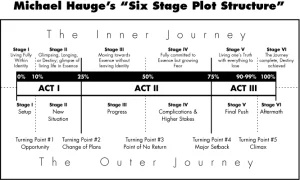Crafting Unforgettable Character Arcs
Character arcs are the backbone of compelling fiction. They give readers a reason to invest in the characters, to care about their journeys, and to see themselves in their struggles and triumphs. We love to fall in love (or hate) with characters, root for them, worry over them, and cheer them on when they overcome hard obstacles and reach the goals they are passionate about.
While all characters in a novel can have arcs, it’s the protagonist whose change should be the most significant. Depending on genre and plot, your hero’s change might be subtle or life-altering. A suspense thriller or cozy mystery may show little character growth by the end, when the bad guy is caught or the mystery solved, whereas a thoughtful women’s fiction novel or relational drama may showcase monumental change.
The Foundation: Three Stages of the Character Arc
While Michael Hauge has a terrific six-act structure for the character arc (which I’ll elaborate on further down), let’s look at the overarching three basic stages to be aware of when crafting a character arc.
Stage 1: Establishing the Status Quo
In Stage 1, introduce your protagonist and their ordinary world. Readers should get a sense of who they are, what they want, and what’s holding them back. This is where the seeds of change are sown, setting the stage for the character’s transformation.
Consider whether your character is embarking on a journey of change, growth, or a tragic fall. The choices you make here will influence the entire narrative.
Stage 2: Confrontation and Transformation
Stage 2 is where your character faces obstacles, conflicts, and dilemmas that challenge their beliefs, values, and flaws. This is where inner and outer conflicts come into play. (See this post on inner conflict.)
Character arcs should be rooted in the character’s inner journey. What fears, doubts, or insecurities are they grappling with? How do these inner struggles manifest in their actions and decisions?
Stage 3: Resolution and Transformation
In the final section, the character’s arc reaches its zenith. They must confront their inner demons and make critical choices that define their transformation. This is the culmination of their growth, change, or tragic descent.
Character Arcs and Theme
Character arcs should also be closely tied to the story’s theme. A well-executed character arc can amplify the thematic message of your story.
For example, if your theme is about the power of redemption, consider crafting a character arc that shows a flawed character seeking to make amends for their past mistakes.
Crafting unforgettable character arcs is an art that requires careful planning, empathy for your characters, and an understanding of narrative structure. By drawing from the insights of Live Write Thrive and Helping Writers Become Authors, you can embark on a journey to create characters that resonate with readers long after they’ve turned the final page.
The Six-Stage Structure
Michael Hague’s Six-Act Story Structure is a valuable framework that offers a fresh perspective on storytelling and provides a roadmap for writers to create emotional connections and dynamic character arcs. I often use this structure when plotting my novels (as well as teach on it).
Your character moves from his persona to his true essence in stages, gradually and in a believable manner. People don’t change overnight. Events erode a person’s grasp on his persona until he can no longer hang on to it. By the end of your story, your character finds no safe haven in that persona any longer. This is what Hague’s story structure centers on—the character moving from persona to essence.
Hague’s Six-Act Story Structure breaks down a story into six distinct stages, each serving a specific purpose in the overall narrative arc.
- The first stage, Setup, introduces readers to the world, characters, and their initial desires and conflicts—specifically the protagonist. It lays the foundation on which the rest of the story will be built.
- Following this, the New Situation stage propels the story forward by presenting the protagonist with an opportunity or a challenge that forces them to take action.
- The third stage, Progress, sees the protagonist embarking on a journey to achieve their goal, facing obstacles and adversaries along the way.
- As the plot unfolds, the Complications and Higher Stakes stage intensifies the conflicts, raising the stakes and pushing the protagonist to their limits.
- The story then reaches a critical turning point in the Crisis stage, where the protagonist must make a profound decision that defines their character development.
- Finally, the Aftermath is the denouement and resolution, allowing readers to witness the consequences of the protagonist’s choices.
When you sit down to work on your character arc, consider using the Six Stage Plot Structure. Brainstorm scenes that will showcase the specific stage your character is in, for each turning point in the story. I also use this, and other, examples in my extensive online course on The 10 Key Scenes That Frame Up Your Novel. If you want to master this, take this course!
Using this framework will not only help you write a solid story, it will aid you in crafting a believable character arc for your protagonist that will engage and delight your readers.
Featured Photo by Alison Wang on Unsplash












